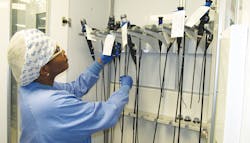Why CS/SPD struggles to provide consistent high quality
When we talk about quality and sterility assurance, we are really talking about patient safety and the impact CS/SPD has on the ultimate quality measurement; surgical site infections (SSI). CS/SPD directly affects a patient’s risk of SSI in two ways as defined by American College of Surgeons and Surgical Infection Society.1 These are “operative time” and “sterilization of surgical equipment”. CS/SPD can extend operative time if the instruments are not available or functional. Additionally, the instruments must be clean and properly sterilized or high-level disinfected to be safe for patient use.
Failure to pre-clean in the OR, delays in processing, not using cleaning accessories or cleaning solutions correctly, poor technique, and failure to follow the manufacturer’s instructions for use (IFU) can mean that the instrument was not properly cleaned. Just because you cannot see the debris, does not mean that the instrument was properly processed. Each step in the IFU must be followed. Extending OR exposure time and/or not properly cleaning/sterilizing the instruments increases patient risks of SSI.
Knowing the need
For these reasons, the most important job of CS/SPD is to ensure that the instruments are available, functional and safe for every patient.
Unfortunately this goal is often not met as there is a silent epidemic of non-sterile and/or non-functional instruments that make their way to the OR every day across the country. If it were not for antibiotics and other steps to minimize SSI, we would likely see this epidemic in the news daily. The reality is that our population is aging and more people will require surgery, bacteria is becoming more virulent and time to antibiotic resistance now is being measured in weeks and months vs. years. This equates to a perfect storm that could result in many more SSI and patient deaths. For these reasons, CS/SPD must do all it can to meet its goals of instrument availability, functionality and safety for every patient.
Causes and contributors
For CS/SPD the root cause of the epidemic is a fundamental flaw in CS/SPD operations/organization structure and a lack of recognition by executive leadership of the importance of CS/SPD for safe patient care. In most CS/SPD every technician is trained and expected to perform all duties with every instrument that comes to the department. The lack of specialization leads to lower quality/safety. The lack of executive recognition of the importance of CS/SPD, leads to low pay, high turnover and low morale amongst technicians. These two root causes go back to the inception of CS/SPD and need to be corrected to end the silent epidemic. Factors exacerbating the problem are:
1. Increases in the numbers and types of surgical procedures and the accompanying complex instruments,
2. Knowledge of the instrument, its IFU and the application of that knowledge to the cleaning and inspection process,
3. Challenging instrument design (lumens, insulation, dead ends).
Evolution outpaces efficacy
Prior to the creation of CS/SPD, nurses who assisted in surgery processed and sterilized the instruments. Thus, the processors had a good-to-excellent understanding of the instruments and their function. At the time, instrumentation was primarily general stainless steel instruments and much less complex than instrumentation today. To standardize instrument processes and to minimize the time that contaminated instruments were in patient treatment areas, CS/SPD were created. Since CS/SPD’s creation, advanced surgical procedures and instrumentation required for the procedures expanded exponentially. With the advent of complex instruments (MIS instruments, endoscopes, video, power and robotic equipment, etc.) came complex instructions for processing e.g., there are over 40 pages of instruction to clean a Di Vinci robot arm. Many of the instruments have complex geometry and in addition to lengthy processing steps, much of the instrument cannot be visualized easily to see if cleaning processes were adequate. Instrument repair companies commonly see debris under insulation, inside channels and lumens when they disassemble instruments. This debris can harbor dangerous microorganisms that can cause infection and even death in susceptible patients.
The importance imperative
Lastly and most importantly, moving instrument processing to CS/SPD meant the loss of the nurses’ knowledge and specialization with the instrumentation. It also relegated cleaning instruments to a similar level of importance as cleaning dishes in food services. Low pay, shift work, non-glamorous work and working conditions combined with constant pressure by the OR, make the SPD technician job very challenging. Additionally, most CS/SPD’s require every technician to rotate through different phases of the CS/SPD processes. The expectation is that every technician must know every instrument in the hospital, and how to disassemble, clean, reassemble, inspect, test and sterilize them. Considering that there are thousands of different instruments in the hospital and hundreds if not thousands of instrument sets, combined with high turnover and subsequent low knowledge levels; the job of the CS/SPD technician is virtually impossible to master resulting in increased patient risks.
The specialization solution
The lack of specialization in CS/SPD results in the average quality of work being well below 100%. The majority of CS/SPD require every technician to perform all duties in the department rotating daily or weekly (disassembly, hand washing, automated washing, reassembly, inspection, testing, packaging sterilization and case cart building for every instrument). The best technicians and less proficient technicians performing all duties lead to safety/quality average of less than 100%. This variation in quality (safety) is a significant point of contention between the OR and CS/SPD and can put patients at risk of SSI. In facilities where there is significant variation in set quality/safety, surgeons’ and nurses’ frustration are high, which can have a negative impact on patient care.
Change for the better
CS/SPD must transition away from the wasteful and inefficient current model and move to an organization structure that allows for specialization. At the same time, engagement with executive leadership is needed to promote the value and benefits of recognizing CS/SPD for its critical role in patient safety and to get the recognition and resources needed to end the silent epidemic of non-sterile, non-functional instruments in the OR. Numerous cost savings opportunities will result from this transformation. SpecialtyCare and some other companies can help you on this journey.
Reference:
1. “Surgical Site Infection Guidelines, 2016 Update January 2017, Volume 224, Issue 1, Pages 59-74”.
About the Author

Gregg Agoston
Vice President, Minimally Invasive Surgical Support
Gregg Agoston is Vice President, Minimally Invasive Surgical Support at SpecialtyCare, which provides allied high and outsourced operating room services.
